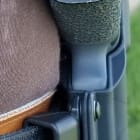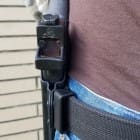Raven Concealment Systems has given first look at their new strong-side outside-the-waistband (OWB) holster to SSD. It is called the Perun, named after the Slavic war god.
The holster can be described as the best features of the Eidolon holster body merged with the body-hugging strong-side profile of the Phantom.

The holster body’s design, clearly based heavily on the Eidolon, significantly reduces the holster’s overall size, making it more concealable. This smaller profile is also more comfortable while seated in vehicles.

Because the body is ambidextrous, it comes with 1.5” belt-loops designed to allow left or right-handed shooters to configure it for either 10-degree cant or a 0-degree cant. This ambidextrous design philosophy has been present in all of RCS’s latest products (like the VanGuard 2, Eidolon, Morrigan, and Copia product families) and simplifies inventory for retailers and government clients because there is no need to try to forecast how many lefty holsters need to be ordered.

Unlike the Phantom (which it replaces in the RCS lineup) the Perun has an innovative adjustable retention slider that allows a uniquely crisp retention that is unmatched by other polymer holsters. Unlike the more traditional “screw-through-rubber gasket” style of adjustable retention, the Perun’s retention design allows easy tension adjustments that do not back off after repeated draws.

It is injection-molded of a polymer blend that is substantially stronger than Kydex or Boltaron, and allows it to remain functional after sustained exposure to high temperature levels that would cause Kydex holsters to lose their form.
The Perun will be available for pre-launch purchase on Black Friday, with units shipping in time to be under the tree for Christmas morning. The first three models it will be available for will be:
Glock 17 (Gen 5/Glock M and backward compatible)
Glock 19 (Gen 5/Glock M and backward compatible)
Glock 43
Following quickly thereafter, will be a Perun LC for:
Glock 19/17/34 + Streamlight TLR-1 HL
Glock 19/17/34 + Surefire X-300U
Followed quickly thereafter by (order subject to change based on .gov orders):
Sig P-320
Sig P-320 Compact
HK VP-9
S&W M&P Shield 9mm (2.0 and backward compatible)
Ruger LC-9
1911 5” Government profile
Springfield XDS
The list will continue to have models added as units move through tool-up and into production.

Additional belt attachment options will also be unveiled in the coming months.
As with all RCS products, they are made in the USA and are backed with an unconditional lifetime warranty.
If you want to be notified the minute they are available, be sure to sign up for the newsletter here.






























































































































